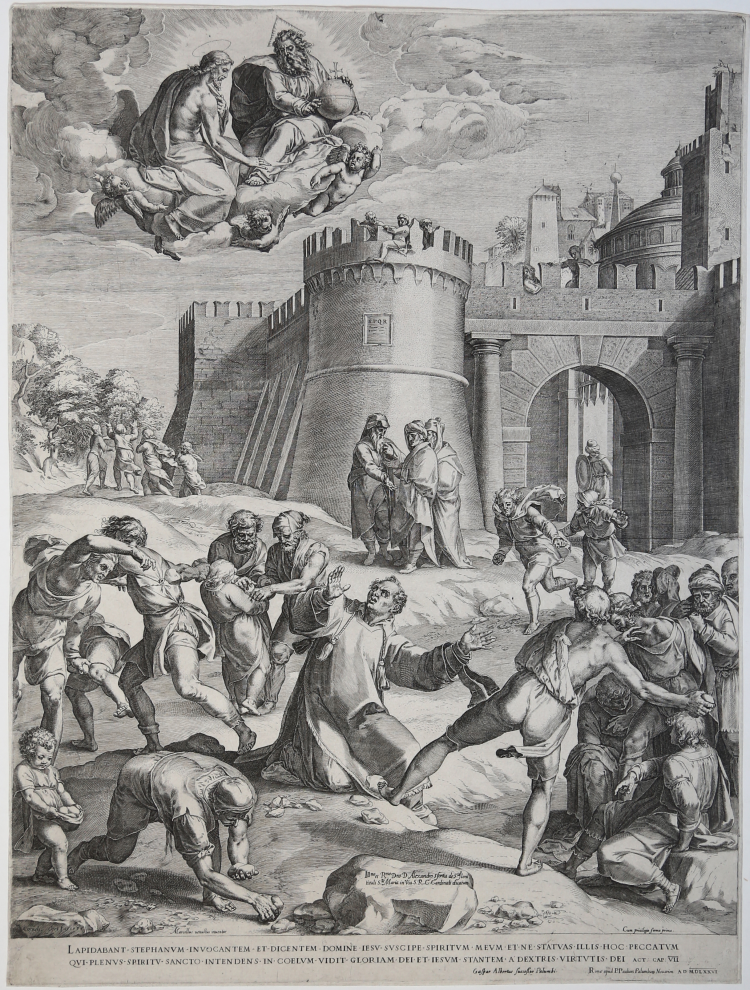



| Reference: | S30152 |
| Author | Cornelis CORT |
| Year: | 1576 |
| Measures: | 428 x 570 mm |


| Reference: | S30152 |
| Author | Cornelis CORT |
| Year: | 1576 |
| Measures: | 428 x 570 mm |
Engraving, 1576, signed and dated at lower left. After Marcello Venusti.
Example of the second state of two with the address of Gaspare Alberti. A fine impression, printed on contemporary laid paper, trimmed to the platemark or with thin margins, a small, repaired area at lower left corner, otherwise in perfect conditions.
The work comes after a painting by Marcello Venusti. His preparatory drawing for the print by Cort is preserved at the National Museum in Stockholm.
The scene represents the time of the stoning (36 or 37 d. C.), outside Jerusalem, to which Stephen, the first martyr of the Church, was condemned by the Jews under the accusation of having blasphemed God. The place of martyrdom is traditionally placed just outside the Damascus Gate, which is observed in the engraving. The composition is divided on two floors. At the bottom, shows Stephen, on his knees, arms outstretched and looking towards the sky, surrounded by a large crowd intent on throwing or collect stones. It is striking on the left, the presence of a child in her lap the stones that the man next to him picks up from the ground, accentuating the look creepy episode. High in the sky, carried by the angels on a cloud, attending the martyrdom Jesus and God the Father, anthropomorphic image with a halo triangular symbol of the Christian Trinity, and his hands resting on the globe surmounted by a cross, the symbol of Christ Salvator Mundi. The inscription at the bottom reminiscent, in fact, that the martyr, shortly before his death, he saw heaven in the glory of God the Father and Jesus at his right hand, and uttered his last words: Domine Jesu Suscipe spiritum meum (Lord Jesus, receive my spirit).
Bibliografia
The New Hollstein, II, p. 28, 79 II/II; Bartsch 52.
Cornelis CORT (Hoorn, nr Alkmaar, 1533 - Roma, prima del 22 Aprile 1578)
|
North Netherlandish engraver and draughtsman, active in Flanders and Italy. His first documented works are a series of engravings issued by the Antwerp publisher Hieronymous Cock, beginning c. 1553. Cort may have been an apprentice within Cock’s establishment, as none of these prints was inscribed with his name until after the plates had passed out of Cock’s hands. A letter of 1567 to Titian from the Netherlandish writer and painter Domenicus Lampsonius (1532–99) describes Cock as Cort’s master. By 1560 Cort had developed a bold and strongly modelled sculptural style of engraving, influenced in part by the Italian Giorgio Ghisi, who worked for Cock between 1550 and 1555. Cort was particularly successful in reproducing the Italianate figure compositions of Frans Floris, after whom he engraved more than 50 prints, notably the Liberal Arts (seven prints; 1565) and the Labours of Hercules (ten prints; 1565). He also reproduced compositions by Maarten van Heemskerck, Andrea del Sarto, Rogier van der Weyden and others while working for Cock.
|
Cornelis CORT (Hoorn, nr Alkmaar, 1533 - Roma, prima del 22 Aprile 1578)
|
North Netherlandish engraver and draughtsman, active in Flanders and Italy. His first documented works are a series of engravings issued by the Antwerp publisher Hieronymous Cock, beginning c. 1553. Cort may have been an apprentice within Cock’s establishment, as none of these prints was inscribed with his name until after the plates had passed out of Cock’s hands. A letter of 1567 to Titian from the Netherlandish writer and painter Domenicus Lampsonius (1532–99) describes Cock as Cort’s master. By 1560 Cort had developed a bold and strongly modelled sculptural style of engraving, influenced in part by the Italian Giorgio Ghisi, who worked for Cock between 1550 and 1555. Cort was particularly successful in reproducing the Italianate figure compositions of Frans Floris, after whom he engraved more than 50 prints, notably the Liberal Arts (seven prints; 1565) and the Labours of Hercules (ten prints; 1565). He also reproduced compositions by Maarten van Heemskerck, Andrea del Sarto, Rogier van der Weyden and others while working for Cock.
|